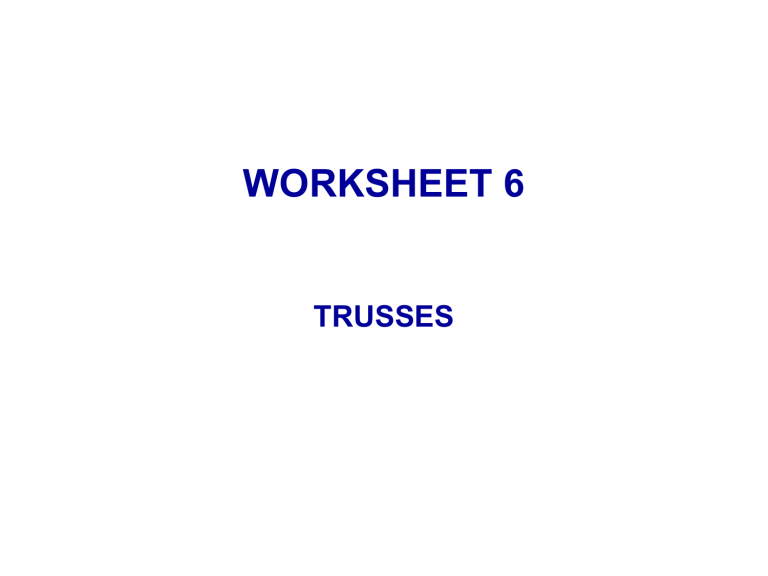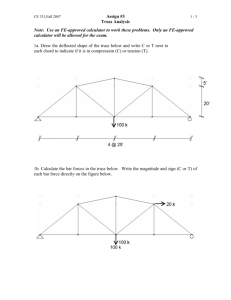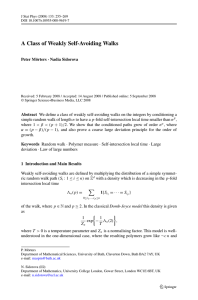WORKSHEET 2 FORCES, MOMENTS, LOADS & SUPPORTS

WORKSHEET 6
TRUSSES
Q1
When would we use a truss?
(a) long spans, loads not too heavy
(b) when want to save weight
(c) when have plenty of depth
(d) when want light appearance
2/24
Q2
When would we not use a truss?
(a) don’t have the depth
(b) very large loads
(c) don’t want fussy appearance
(d) can’t provide lateral support if needed
3/24
Q3
What are the main characteristics of trusses?
(a) assembly of (short) linear members
(b) members connected to form triangles
(c) joints pinned
(d) loads applied at panel points (joints)
(d) members carry only tension or compression forces
4/24
Q4
What materials are trusses most commonly made of?
(a) steel
(b) timber
(c) concrete (very occasionally)
5/24
Q5
How are the joints commonly made?
( a) in timber trusses
(i) using gangnail joints - light timber
(ii) using gusset plates
(iii) overlapping/double members and bolts
(iv) concealed plates - bolts
(b) in steel trusses
(i) gusset plates
(ii) welded joints
6/24
Q6
What do the following do?
(a) the chords
(i) chords resist the bending moment
(ii) top chords take the compressive forces
(in a triangular truss, the top chord also resists shear)
(iii) bottom chords take the tensile forces
( b) the web members
(i) resist the shear forces
7/24
Q7
What are the common span-to-depth ratios for:
(a) timber beams?
18-20:1
(b) trusses?
5-10:1
8/24
Q8
In the truss below show where:
(a) the maximum compressive force in a chord occurs
(b) the maximum tensile force in a chord occurs
(c) the maximum shear force in a web member occurs
(a)
(c) (c)
(b)
9/24
Q9
In the truss below show where:
(a) the maximum compressive force in a chord occurs
(b) the maximum tensile force in a chord occurs
(c) the maximum shear force in a web member occurs
(c)
(a)
(b)
10/24
Q10 (a)
(a) given the force shown, what is
(i) the horizontal component?
H = 10 cos 45
= 7.07 kN to the right
(ii) the vertical component?
V = 10 sin 45
= 7.07 kN down
V
45 o
H
10kN
11/24
Q10 (b)
(b) given the force shown, what is
(i) the horizontal component?
H = 6 cos 30
= 5.2 kN to the right
(ii) the vertical component?
V = 6 sin 30
= 3.0 kN up
V
6kN
30 o
H
12/24
Q10 (c)
(c) given the two forces shown, use the parallelogram of forces or the triangle of forces to find the resultant force
6kN
6kN
Ø o
R
8kN
R = (6
2
+ 8
2 )
= 10 kN at 36.87
o
R
Ø o
6kN
8kN
Tan Ø
Ø
= 6 / 8 = 0.75
= 36.87
o
8kN
13/24
Q11
Analyze the truss shown below using the Methods of Joints
4 bays @ 3m
1kN 2kN 2kN 2kN 1kN
B C E
3m
A D
45 o
F
R1=4kN R2=4kN
First find the reactions. Using symmetry R1 = R2 = 8/2 = 4kN
Assume all forces are in tension - i.e. away from the joint
14/24
Q11 (cont1.)
AB
A AD start at joint A
(support) vertically: 4 + AB = 0
AB = -4.0 (compression) horizontally : AD = 0
4
1
B
BA
4
BC
BD next at joint B.
vertically: 1 - 4 + BDsin45 o
= 0
BD = +4.24 (tension) horizontally: BC +4.24 cos45 o
= 0
BC = -3.0 (compression)
DB
(4.24)
DC
DA
(0) D
DF next at joint D.
vertically: 4.24sin45
o
+ DC = 0
DC = -3.0 (compression) horizontally : 0 +DF -4.24 cos45 o
= 0
DF = +3.0 (tension)
15/24
CB
3
C
2kN
CD
3
CE
CF
Q11(cont2.) next at joint C vertically: 2 - 3 + CFsin45 o
= 0
CF = +1.41 (tension) horizontally : 3 +CE +1.41cos45
o
= 0
CE = -4.0 (compression)
EC
4
E
2kN
EF
EG
4 next at joint E.
vertically: 2 + EF = 0
EF = -2.0 (compression)
That completes half the truss. The other half is the same by symmetry
16/24
Q11 (cont3.)
1kN 2kN 2kN 2kN 1kN
B
3
C
4
E
A
4 4.24
0
D
3 1.41
3
F
2
4 3
1.41
3
3
4.24
4
0
Note that the biggest chord forces are near the middle and the biggest web forces are near the ends
Always true for parallel chord trusses with fairly uniform loading
17/24
Q12
For the same truss use the Methods of Sections to find the forces in members BD, CE and DF
4 bays @ 3m
1kN 2kN 2kN 2kN 1kN
B C E
3m
A D
45 o
F
R1=4kN R2=4kN
First find the reactions. Using symmetry R1 = R2 = 8/2 = 4kN
Assume all forces are in tension - i.e. away from the joint
18/24
Q12(cont1.)
Make a cut through the truss passing through the member wanted, BD
1kN
B C
A
4
D
Consider the left part of the cut as a freebody
Mark all the forces on it - including those members cut off the freebody is in equilibrium
Using V = 0
4 - 1 -BD sin45 o = 0 BD = 4.24 (tension)
19/24
Q12(cont2.)
Make another cut through the truss passing through the other members wanted, CE and DF
1kN 2kN
3m
B C
A
4
E
D
3m 3m
F
Mark all the forces on it - including those members cut off the freebody is in equilibrium
Using M = 0 about F - consider all the forces on the left
4 x 6 - 1x 6 - 2 x 3 +CE x 3 = 0 CE = -4.0 (compression)
Using M = 0 about C
4 x 3 - 1x 3 - DF x 3 = 0 DF = +3.0 (tension)
Note that we have found only the members we wanted
20/24
Q13
For the same truss use the Graphical Method to construct a Maxwell diagram and find the forces in the members
4 bays @ 3m
1kN 2kN 2kN 2kN 1kN
3m
45 o
R1=4kN R2=4kN
First find the reactions. Using symmetry R1 = R2 = 8/2 = 4kN
21/24
Q13(cont1.)
First annotate using Bow’s Notation
(label spaces between members and forces)
3m
4 bays @ 3m a
1kN 2kN 2kN 2kN 1kN b c d e h i j k l m g n
0 f
R1=4kN R2=4kN
First find the reactions. Using symmetry R1 = R2 = 8/2 = 4kN
22/24
Q13(cont2.)
Next select a scale and draw a line representing all the loads and reactions all the loads are vertical - so is the line the line is the line a , b , c , d , e , f ( ag , gf ) ab = 1, bc = 2,...etc ag = 4, gf = 4 k i begin with a zone near a reaction, e.g h ah is vertical and gh is horizontal - meet at g
( h & g at same point) hg is 0 take next zone i bi is horizontal and ih is at 45 o they meet at i
- draw these lines l
Now ij is vertical and jg is horizontal. This locates j n j m
Proceed to k in same way and half the truss is solved
Measure all lines - this gives the force in each member need to use a special convention to determine tension or compression a b
4
3
2 c g h o d
1
0 scale for forces e f
23/24
Q14
When would you use:
(a) the Method of joints?
When want to do detailed design and need to know all the forces in all members
(b) the Method of Sections?
When want to know only a few member forces e.g. end diagonals and middle chords
(b) the Graphical Method
When don’t have a calculator or don’t want to calculate
24/24




